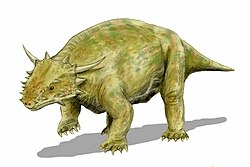| Shihtienfenia Temporal range: Changhsingian, | |
|---|---|
 | |
| Fossils on display at the Paleozoological Museum of China | |
| Scientific classification | |
| Domain: | Eukaryota |
| Kingdom: | Animalia |
| Phylum: | Chordata |
| Clade: | † Parareptilia |
| Order: | † Procolophonomorpha |
| Clade: | † Pareiasauria |
| Family: | † Pareiasauridae |
| Genus: | † Shihtienfenia Young & Yeh, 1963 |
| Type species | |
| †Shihtienfenia permica Young & Yeh, 1963 | |
| Species | |
| |
| Synonyms [1] | |
| |
Shihtienfenia is an extinct genus of pareiasaurid parareptile from the Late Permian of China. [1]



